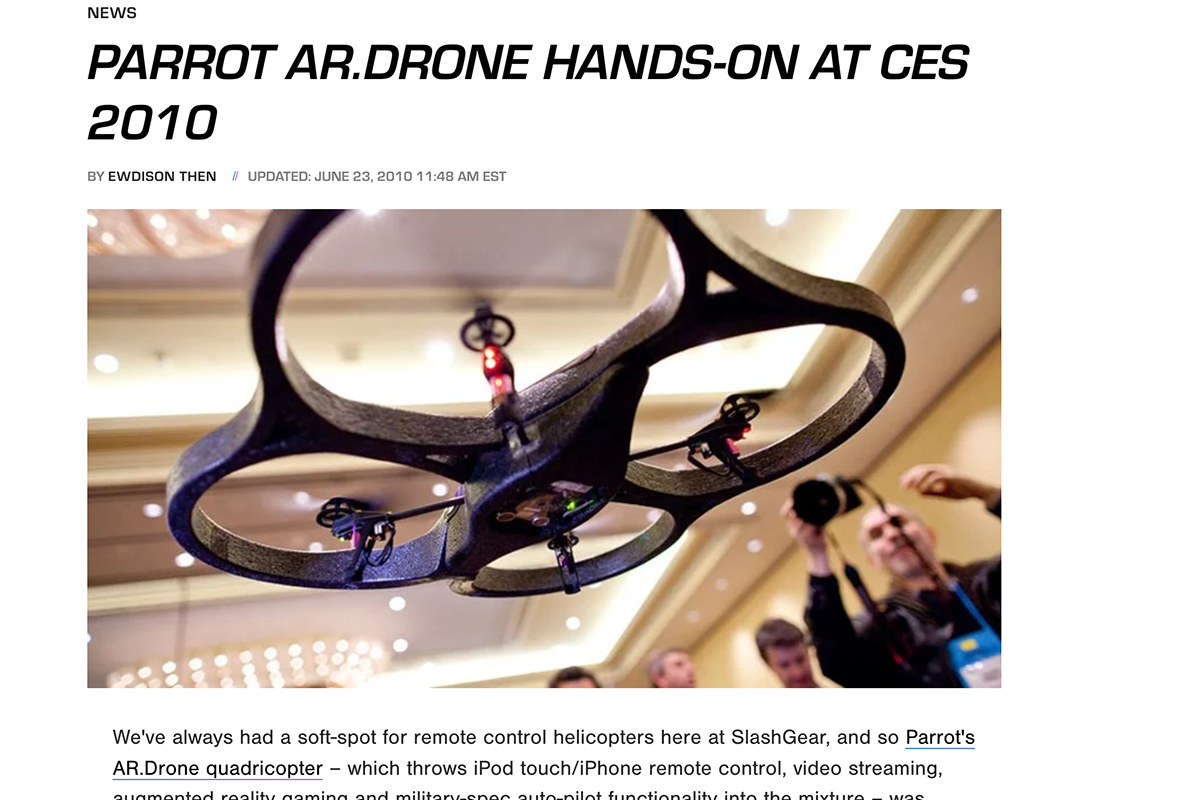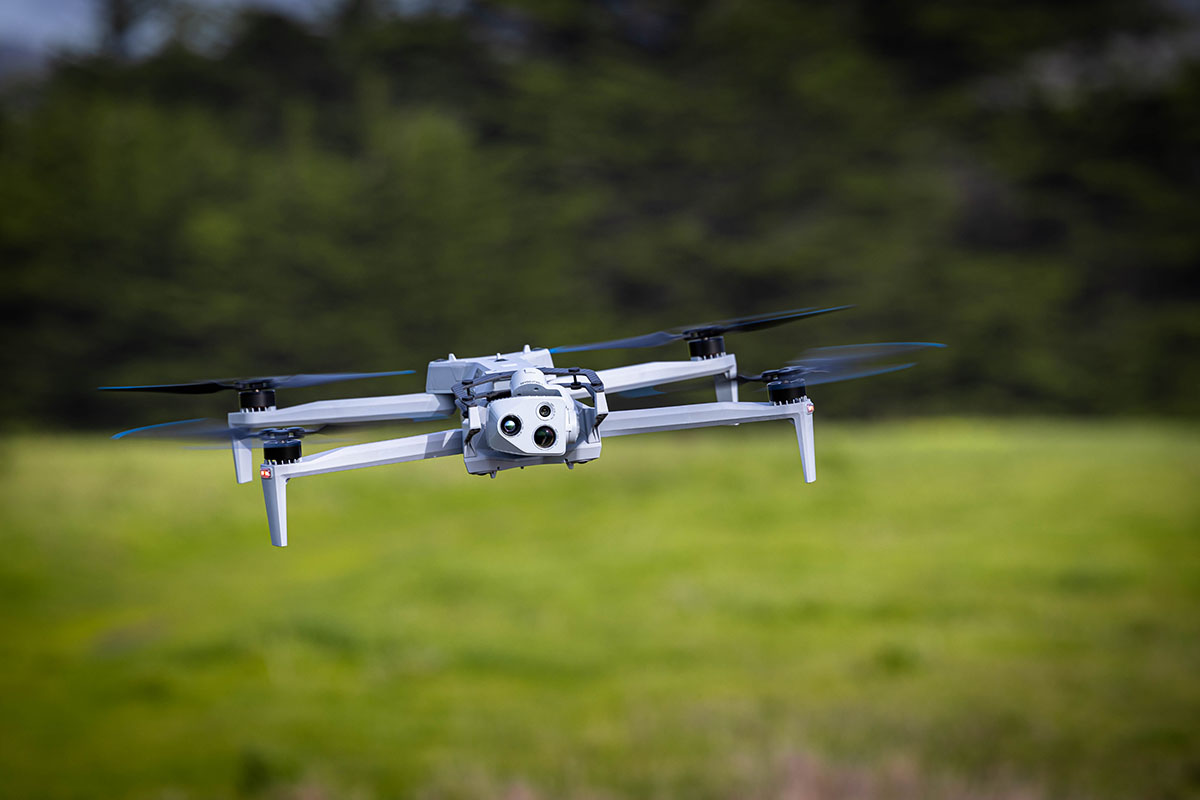The modern drone industry was born in garages and hobby shops. In the early 2000s, remote-controlled (RC) aircraft were the province of engineers, model-plane enthusiasts, and a few university labs experimenting with GPS and autopilot systems. The idea of an “unmanned aerial vehicle” (UAV) sounded like the province of the military, far from everyday life. That all began to change as the smartphone supply chain matured.
Accelerometers, gyroscopes, and cameras—components that were once expensive and rare—became cheap and accessible to anyone. Chris Anderson, then editor of Wired and later founder of 3D Robotics, called this “the peace dividends of the smartphone war.” The miniaturized components first developed for iPhones and Androids laid the groundwork for drones. What began as a hobby was now poised to become a product category.
By 2010, the pieces had come together: open-source flight controllers like ArduPilot, lightweight GoPro cameras, and compact brushless motors. American startups such as 3D Robotics, Airware, and GoPro imagined a future of consumer drones that would change photography, surveying, and eventually transportation. It looked, for a moment, like Silicon Valley might own the skies.

DJI and the first American retreat
While U.S. startups were designing prototypes, DJI was learning to manufacture. Founded in 2006 in Shenzhen, DJI built on China’s unique advantage: a complete hardware ecosystem within a single city. Parts could move from concept to production in days. By 2015, the company’s Phantom and Mavic models had become the face of consumer drones.
American companies could not match DJI’s speed or cost. GoPro’s Karma drone failed after recalls. Airware and 3D Robotics ran out of capital. The American drone boom of the early 2010s ended almost as quickly as it began.
But that collapse prompted a shift in thinking. Competing with DJI on price was off the table. Competing on intelligence might not be.

Differentiation through autonomy
Skydio emerged in 2014 with a different philosophy: drones could (and should) fly themselves. The company’s founders, including CEO Adam Bry, came from MIT’s robotics program, where they had studied computer vision and control systems. Instead of depending on a pilot’s skill, their drones would understand the environment and make decisions in real time.
This early focus on autonomy gave Skydio a natural edge in the new era of AI. “We make flying robots that give people superpowers,” Bry said in an interview with Jon Bruner on the Go/No-Go podcast. He charts the evolution of the industry as moving from toys to tools to infrastructure: drones that were once just for fun now perform critical work in law enforcement, energy, and defense.

That evolution also had implications for the business model. Skydio’s products are designed, built, and tested in the United States, which is almost unheard-of in modern electronics. This vertical integration can lengthen the product development timeline, but the strategic importance of a secure supply chain outweighs its drawbacks. As AI becomes central to navigation and safety, having full control over hardware and software reduces risk and builds trust with institutional customers.
Manufacturing trust
By the late 2010s, DJI’s dominance had drawn political scrutiny. U.S. agencies grew uneasy about using Chinese-made equipment for sensitive data collection. The Department of Defense responded with the Blue sUAS program to certify domestically produced drones. The conversation shifted from market competition to national security.
However great the risks, reshoring an entire supply chain cannot happen overnight, and it might not even be possible within our lifetimes. Most drone components, including batteries, motors, image sensors, and plastics, still originate in China. Batteries are the hardest link to replace. China controls roughly three-quarters of global cell production and nearly all of the raw-material refining. Korea, Japan, and Taiwan offer partial alternatives, but the industrial gap is wide.
U.S. manufacturers are now rebuilding local ecosystems, combining domestic assembly with allied sourcing. New facilities in California, Texas, and Mexico focus on short-run, high-reliability production rather than mass volume. This follows the model of American dominance in aerospace manufacturing, doubling down on precision rather than competing on price.
Drones as critical infrastructure
When drones move into public safety, defense, and energy, they become enmeshed in national infrastructure. Bry often draws this parallel directly: drones are no longer gadgets or tools but “critical physical infrastructure” in their own right. They monitor grids, assess storm damage, and assist in policing and firefighting.
As drones evolve from cameras to critical infrastructure, reliability becomes non-negotiable. A failure in flight can interrupt power delivery, compromise inspection data, or delay an emergency response. For autonomous systems, the standard is even higher: the AI cannot guess, hallucinate, or forget. Every component must perform predictably despite heat, dust, and fatigue. Ensuring that consistency now depends on advanced inspection methods, including industrial CT, which allows engineers to see inside complex assemblies, verify structural integrity, and catch hidden defects before they lead to failures in the field.

This is where American firms have an advantage, especially in the Bay Area where everyone from hard tech startups to power players like OpenAI and Anthropic are continuing to build the future of AI. Building autonomy into hardware is less about cheap components and more about tightly integrating the full stack of training, testing, and iteration between software and production. It requires the kind of engineering culture that thrives close to the factory floor.
Policy and the next industrial race
The federal government has begun to treat drone manufacturing as strategically important. The FCC now has authority to restrict or retroactively ban transmitters from companies tied to national-security risks. Reports of disguised DJI products, sold under new brand names to evade import rules, have reinforced the urgency of domestic production.
Replacing China’s dominance will take years. It means building not just factories but the networks of suppliers, machinists, and engineers that make quick iteration possible. The lessons from electric vehicles and semiconductors are clear: reshoring works only when supported by steady procurement, tax incentives, and long-term demand.

The emerging model is regional, not isolationist. Allied sourcing across Japan, Korea, and Taiwan can provide resilience without abandoning cost efficiency.
A new phase of flight
The first drone era was about invention, but the next is about comprehensive industrialization. Drones’ transition from toys to tools to infrastructure captures more than a shift in technology. It marks the moment when drones stop being products and start being part of the built environment, flying machines that belong to the same world as power lines and cell towers. And these hard-won lessons learned by the drone industry offer a blueprint for the rest of American manufacturing.
For U.S. companies like Skydio, that evolution may prove decisive. Autonomy is where America is already leading, not by racing to the bottom on price, but through the smarter integration of AI into real, physical systems. The products that will define the next decade will be those whose proven reliability at every level can’t help but earn our trust.




